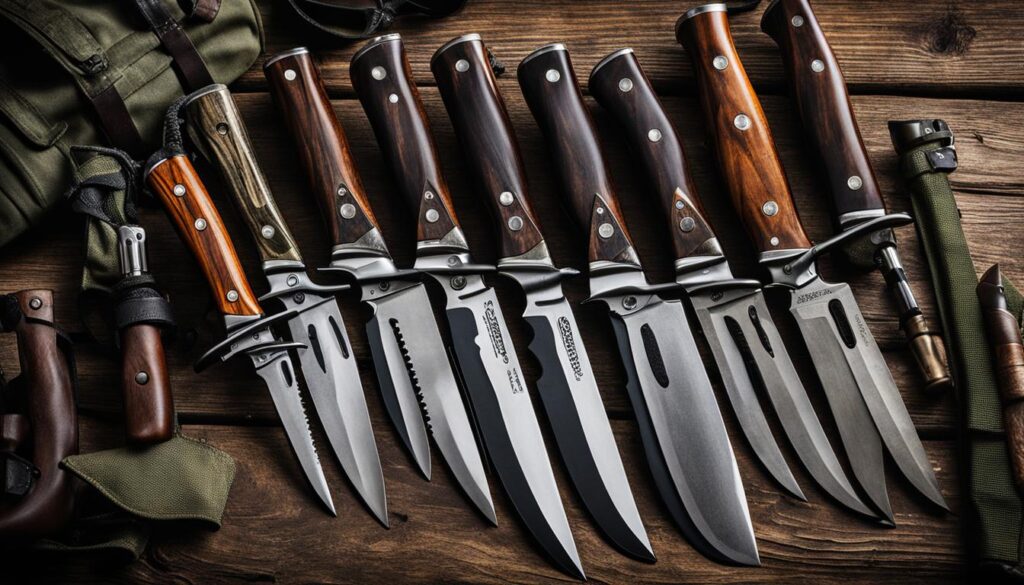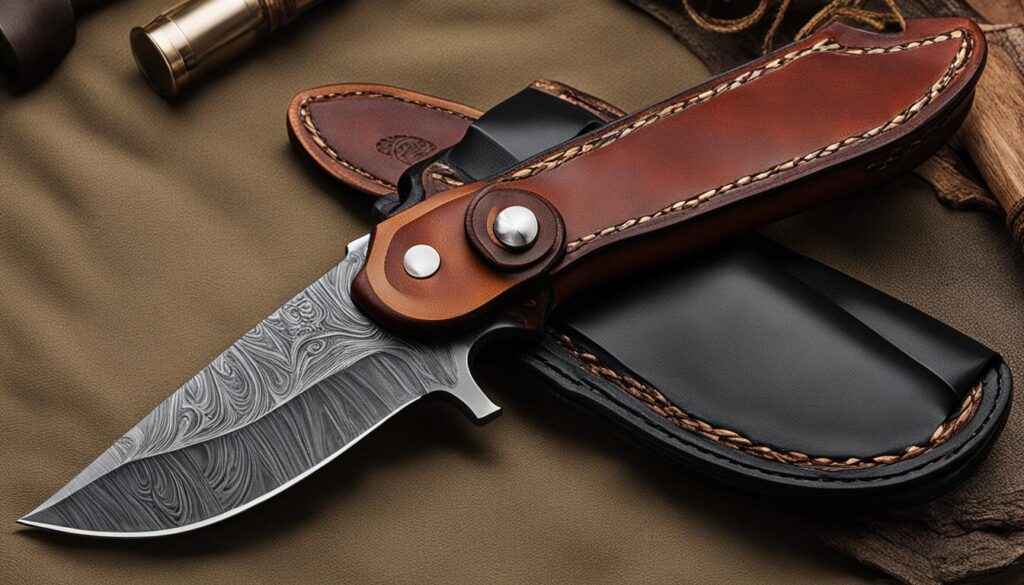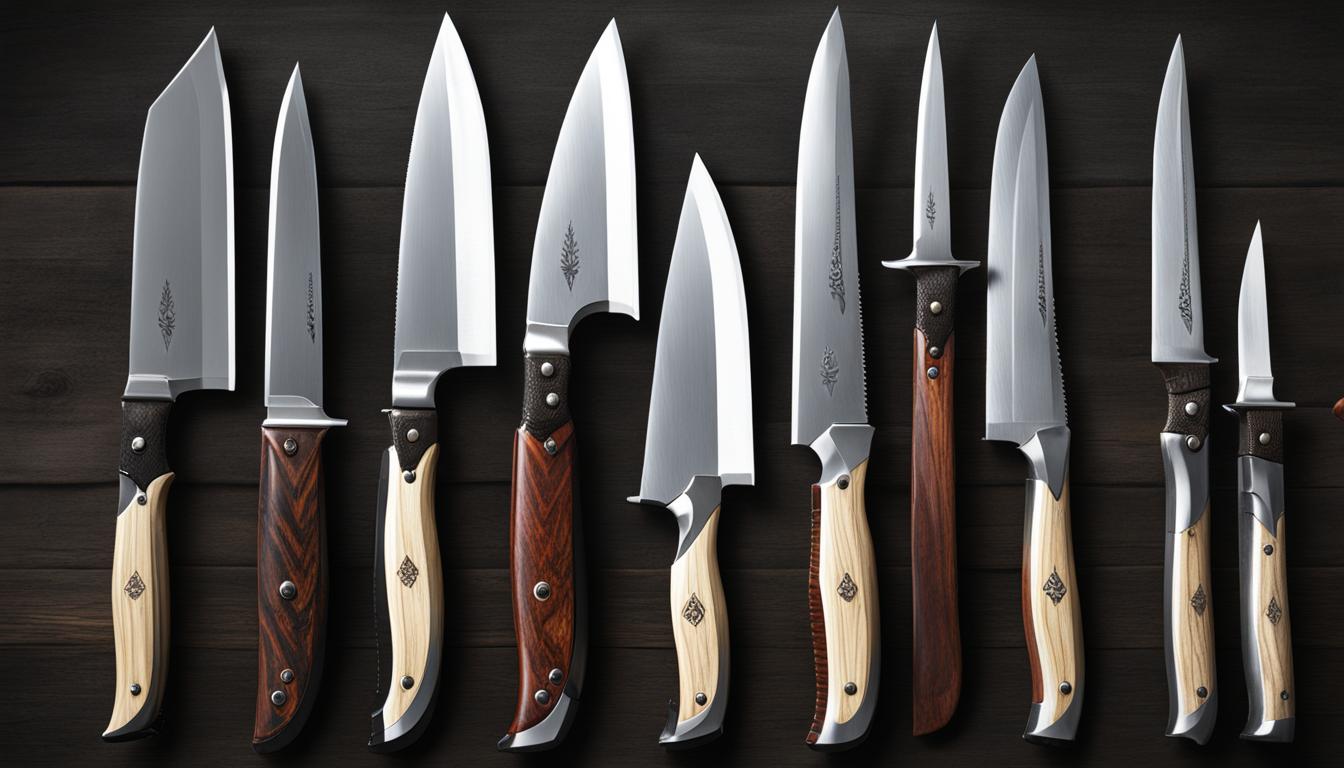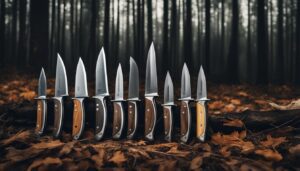When it comes to skinning game during hunting, having the right blade length is essential. As a hunting knife enthusiast, I understand the importance of precision and control when field dressing. In this guide, I will share expert insights on the best blade lengths for skinning, helping you make an informed choice for your hunting adventures.
Key Takeaways:
- Blade length between 2 and 4 inches is optimal for skinning.
- Smaller blades, like those used by surgeons, provide better control and precision.
- A larger blade increases the risk of cutting unwanted areas and can be difficult to maneuver.
- A shorter knife is lighter and less likely to get in the way during transportation.
Factors to Consider When Choosing a Hunting Knife
When it comes to choosing a hunting knife, there are several important factors to consider. The right knife can make a significant difference in your hunting experience, so it’s essential to understand the various features and options available.
Blade Type: Folding vs. Fixed Blade
One of the first decisions you’ll need to make is whether to choose a folding knife or a fixed blade knife. Folding knives are more compact and easier to carry, making them convenient for hunters who want to minimize bulk in their gear. On the other hand, fixed blade knives offer greater strength and durability, making them ideal for heavy-duty tasks like field dressing.
Gut Hook: Useful or Not?
Another factor to consider is whether to opt for a hunting knife with a gut hook. A gut hook is a small, curved blade on the spine of the knife that makes it easier to open up the abdominal cavity of an animal during field dressing. While some hunters swear by gut hooks for their convenience, others prefer knives without this feature to maintain a more versatile tool.
Additional Features
Aside from the blade type and gut hook, there are other features to consider. Some hunting knives come with serrated edges, which can be useful for cutting through tough materials like tendons and cartilage. Others may have built-in saw blades, which can come in handy for tasks like cutting through bone or preparing firewood.
Ultimately, the best hunting knife for you will depend on your personal preferences and the specific tasks you’ll be performing. Consider the type of game you’ll be hunting, the environments you’ll be in, and the level of convenience and versatility you’re looking for. By carefully evaluating these factors, you can ensure that you choose a hunting knife that meets your needs and enhances your hunting experience.
Table: Comparison of Folding and Fixed Blade Hunting Knives
| Folding Knives | Fixed Blade Knives | |
|---|---|---|
| Compactness | Highest | Lowest |
| Strength | Medium | Highest |
| Durability | Medium | Highest |
| Convenience | Highest | Medium |
Note: The table provides a general comparison between folding knives and fixed blade knives based on several key factors. Individual knife models may have variations in features and performance.
Handle and Blade Material
When it comes to hunting knives, the materials used for the handle and blade play a crucial role in performance and durability. Let’s explore the different handle and blade materials commonly used in hunting knives.
Handle Material
The handle is an essential part of a hunting knife as it provides grip and comfort during use. There are various handle materials to choose from, each with its own advantages and characteristics. Some popular handle materials include:
- Wood: Wood handles offer a classic and natural look. They provide excellent grip and are comfortable to hold. However, wood handles may require more maintenance to keep them in good condition.
- Leather: Leather handles are known for their durability and aesthetic appeal. They offer a firm grip and can withstand outdoor conditions. Leather handles often require some break-in period to achieve maximum comfort.
- Synthetic materials: Synthetic handles, such as rubber, polymer, or composite materials, offer excellent grip even in wet conditions. They are lightweight, durable, and require minimal maintenance.
Blade Material
The blade material is essential for the cutting performance, edge retention, and overall durability of a hunting knife. Two common blade materials used in hunting knives are carbon steel and stainless steel.
“Carbon steel blades are preferred by many hunters for their exceptional strength and edge retention. They are known for their sharpness and are relatively easy to sharpen. However, carbon steel blades are more prone to rust and require regular maintenance to prevent corrosion.”
Stainless steel blades, on the other hand, offer excellent resistance to corrosion, making them ideal for hunters who frequently deal with wet environments. However, stainless steel blades may be harder to sharpen and may not hold an edge as well as carbon steel blades.
Table: Handle and Blade Material Comparison
| Handle Material | Pros | Cons |
|---|---|---|
| Wood | Natural look, excellent grip | Requires maintenance |
| Leather | Durable, aesthetic appeal | May require break-in period |
| Synthetic materials | Excellent grip, lightweight, low maintenance | No natural look |
| Blade Material | Pros | Cons |
|---|---|---|
| Carbon Steel | Exceptional strength, sharpness, easy to sharpen | Prone to rust, requires maintenance |
| Stainless Steel | Corrosion resistance | Harder to sharpen, may not hold edge as well |
Choosing the right handle and blade material for your hunting knife is a personal preference based on your needs and the environment you’ll be hunting in. It’s essential to consider the advantages and disadvantages of each material to make an informed decision that suits your hunting style.
Blade Styles and Variations
When it comes to hunting knives, the blade style and shape play a crucial role in determining their functionality and performance. Different blade styles are designed for specific purposes, and understanding the variations available can help you make an informed decision. In this section, we will explore the three main blade styles commonly used in hunting knives: drop point, clip point, and trailing point.
Drop Point
The drop point blade is one of the most popular and versatile choices for hunting knives. It features a strong, curved blade that slopes gently from the handle to the tip, creating a broad and robust edge. This blade style offers excellent control and stability, making it ideal for skinning and field dressing. The drop point design minimizes the risk of puncturing internal organs or damaging the hide, ensuring clean and efficient cuts.
Clip Point
The clip point blade is characterized by a thinner, more pointed tip that curves slightly upward. This style of blade is known for its precision and piercing ability, making it suitable for tasks that require more delicate and detailed work. However, clip point blades may not be as robust as drop point blades and can be prone to breaking if subjected to excessive force. They are commonly used for tasks such as caping or precision cuts.
Trailing Point
The trailing point blade, also known as a skinning blade, is characterized by an upward curve along the spine of the blade, creating a larger cutting surface. This blade style excels in slicing and skinning applications, allowing for long, smooth cuts through the hide. Hunters who process large game or prefer a slicing motion often prefer trailing point blades. However, the extended belly of the blade also makes it less suitable for tasks that require precision or piercing.
| Blade Style | Characteristics | Best Uses |
|---|---|---|
| Drop Point | Curved blade, broad edge | Skinning, field dressing |
| Clip Point | Thin, pointed tip | Caping, precision cuts |
| Trailing Point | Curved blade, extended belly | Slicing, skinning |
Special Features and Considerations
When it comes to hunting knives, there are a variety of special features and considerations that can enhance your experience in the field. These features can be a matter of personal preference and may not be essential for all hunters, but they are worth exploring. Let’s take a closer look at some of the notable options:
Gut Hook
A gut hook is a small, curved blade on the spine of the hunting knife that is designed to assist with field dressing. It allows for quick and precise opening of the animal’s abdomen without puncturing the internal organs. While a gut hook can be a valuable tool, especially for large game, it is not necessary for all hunting scenarios.
Serrated Edge
A serrated edge on a hunting knife can be beneficial for cutting through tough materials such as tendons and cartilage. The serrations provide extra gripping power and make slicing through these challenging areas easier. However, keep in mind that a serrated edge may require special maintenance and sharpening techniques compared to a plain edge.
Saw Blade
Some hunting knives come with a built-in saw blade on the spine or handle. This feature can be useful for tasks such as sawing through bone, cutting kindling for a fire, or other cutting needs that may arise in the field. If you anticipate these types of tasks on your hunting trips, a knife with a saw blade could be a valuable addition to your gear.
It’s important to note that while these special features can be advantageous, they may also add weight and bulk to your hunting knife. Consider the specific requirements of your hunting trips and choose a knife with the features that align with your needs. Remember that the ultimate goal is to have a knife that is comfortable to use and meets your specific hunting requirements.
Top Hunting Knife Recommendations
When it comes to choosing a hunting knife, there are numerous options available on the market. To help you make an informed decision, I have compiled a list of some of the best hunting knives recommended by hunters and experts:
- Spyderco Bill Moran
- Buck Model 110
- Fallkniven H1z
- Gerber Gator Fixed Blade
- CRKT Onion Skinner
These hunting knives have received positive reviews for their quality, durability, and performance in the field. Let’s take a closer look at each of them:
| Name | Blade Length | Blade Material | Handle Material |
|---|---|---|---|
| Spyderco Bill Moran | 3.875 inches | VG-10 stainless steel | Micarta |
| Buck Model 110 | 3.75 inches | 420HC stainless steel | Dymondwood |
| Fallkniven H1z | 3.1 inches | Laminate VG-10 stainless steel | Thermorun |
| Gerber Gator Fixed Blade | 4.02 inches | 420HC stainless steel | Gator Grip |
| CRKT Onion Skinner | 3.75 inches | 8Cr13MoV stainless steel | Walnut |
These hunting knives offer a range of blade lengths, blade materials, and handle materials to suit different preferences and needs. Whether you prioritize edge retention, corrosion resistance, or grip comfort, there is a knife on this list for you. Remember to consider your specific hunting activities and requirements when making your final decision.

With any of these top hunting knives, you can trust in their performance and reliability in the field. However, it’s important to choose a knife that feels comfortable in your hand and suits your individual hunting style. Happy hunting!
Importance of a Good Knife Sheath
The importance of a good knife sheath cannot be overstated when it comes to hunting. A sheath not only allows you to safely carry your hunting knife but also protects the blade from damage and keeps it securely in place. When choosing a knife sheath, there are several factors to consider, including the material, design, and blade protection it offers.
One crucial aspect of a knife sheath is the material it is made from. Leather sheaths are a popular choice for their durability and classic look. They provide a snug and secure fit for the knife and offer excellent protection against accidental cuts. Synthetic sheaths made from thermofabrications are also available and offer their own set of advantages such as water resistance and ease of maintenance.
The design of the sheath is another important consideration. It should have a positive retention system, ensuring that the knife stays in place even during rigorous activities. The sheath should also prevent the blade from coming in contact with the stitching, as this can cause damage to the cutting edge. Additionally, a well-designed sheath should provide proper protection from the elements, keeping the blade dry and corrosion-free.
A good knife sheath not only keeps your hunting knife safe but also allows for quick and easy access when needed. It should be designed to securely hold the knife and provide a comfortable and convenient carry. By investing in a quality sheath, you can ensure that your hunting knife remains in optimal condition, ready to serve you in the field.


Conclusion
Selecting the right blade length for skinning is crucial for efficient and precise field dressing. A blade length between 2 and 4 inches is recommended for optimal control and maneuverability. This range allows for greater precision while reducing the risk of cutting unwanted areas during skinning.
When choosing a hunting knife, it is important to consider several factors. Firstly, decide between a fixed or folding blade based on your preferences and the intended use. Fixed blades offer ruggedness and ease of cleaning, while folding knives are more compact and convenient to carry.
The handle and blade material are also important considerations. Choose a handle material that provides a good grip and durability. Common options include wood, leather, antler, bone, and synthetic materials. For the blade, experts recommend high carbon steel for its strength and edge retention. However, stainless steel blades are also popular for their corrosion resistance.
Blade style and special features can enhance your hunting experience. Different blade shapes, such as drop point, clip point, and trailing point, offer unique advantages. Additionally, some knives come with special features like a gut hook, serrated edge, or saw blade. Consider these features based on your personal preferences and hunting needs.
Lastly, a good knife sheath is essential for safely carrying and protecting your hunting knife. Look for a sheath made of leather or synthetic materials, with a secure retention system and proper blade protection. A reliable sheath ensures that your knife is readily accessible while minimizing the risk of accidents or damage. Ultimately, the best hunting knife for you will depend on your personal preferences and needs as a hunter.
FAQ
What is the optimal blade length for skinning?
According to experts, the optimal blade length for skinning is between 2 and 4 inches.
What type of blade do surgeons use for precision?
Surgeons use scalpels, which have smaller blades, for more control and precision.
Why is a larger blade not recommended for skinning?
A larger blade increases the risk of cutting unwanted areas and can be difficult to maneuver during field dressing.
Are folding knives or fixed blade knives better for hunting?
Fixed blade knives are generally more rugged and easier to clean, while folding knives are more compact and convenient to carry.
Do I need a gut hook on my hunting knife?
A gut hook can be a useful feature for field dressing but is not essential.
What are the recommended handle materials for a hunting knife?
Options for handle materials include wood, leather, antler, bone, and synthetic materials.
What is the preferred blade material for a hunting knife?
High carbon steel is preferred by experts for its strength and edge retention. Stainless steel blades are also popular for their corrosion resistance.
What are the different blade shapes available for hunting knives?
Blade shapes for hunting knives include drop point, clip point, and trailing point.
Is a gut hook, serrated edge, or saw blade necessary on a hunting knife?
These features are a matter of personal preference and may not be essential for all hunters.
What are some popular hunting knife brands?
Some popular choices among hunters include Spyderco Bill Moran, Buck Model 110, Fallkniven H1z, Gerber Gator Fixed Blade, and CRKT Onion Skinner.
What is the importance of a good sheath for a hunting knife?
A good sheath is essential for safely carrying and protecting your hunting knife. It should securely hold the knife, have a positive retention system, and provide proper protection from the elements.





